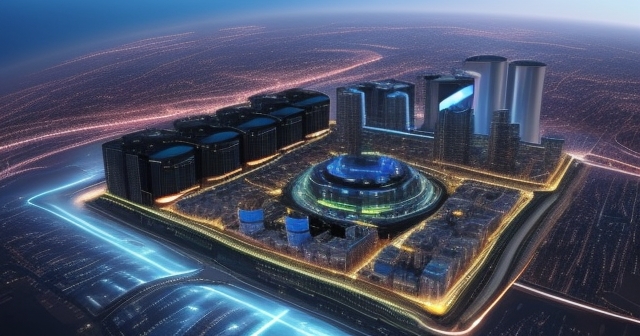Welcome to an exploration of one of the most ambitious corporate energy plays in recent history. Microsoft, the tech behemoth synonymous with software and cloud computing, has thrown its considerable weight behind a technology long confined to the realm of science fiction and distant futures: nuclear fusion. But they aren’t just investing; they’ve signed a power purchase agreement (PPA) with a startup called Helion Energy, targeting electricity delivery within an astonishingly short five years. This move has sent ripples through both the energy sector and the scientific community, sparking intense debate about the true timeline for commercially viable fusion power. For us, as individuals interested in the intersection of technology, energy, and markets, understanding this bold strategic pivot is crucial. It’s a potential signal of profound shifts that could impact everything from the cost of computing to global energy security and investment landscapes.
We’re used to hearing about fusion as something decades away, perhaps arriving in the latter half of this century. International projects like ITER embody this long-term, complex research approach. Yet, here is one of the world’s largest companies, committing to buy fusion energy from a private company by 2028. What does Microsoft see that many experts don’t? Or are they simply making a high-stakes wager on accelerated technological progress? Let’s unpack this complex situation, exploring the deal itself, the contrasting timelines, Microsoft’s compelling motivations (particularly the voracious energy appetite of AI and datacenters), and the potential role of cutting-edge technology like AI in speeding up fusion development. By the end, you should have a clearer picture of why Microsoft’s bet is generating so much buzz, and what it might mean for the future we’re building.

At the heart of this story is a PPA signed in May 2023. Microsoft agreed to purchase 50 megawatts (MW) of power from Helion Energy. While 50 MW might sound modest compared to the gigawatts (GW) a large city consumes, it’s a significant initial step for a completely new energy source. What makes this agreement truly unprecedented is the timeline: Helion is contracted to deliver this power to the grid by 2028. This isn’t a research grant or a speculative investment in future potential; it’s a commercial contract for actual electrons flowing into the grid, with real-world consequences if milestones are missed.
Microsoft President Brad Smith articulated the company’s position, stating they were “optimistic that fusion energy can be a breakthrough that helps the world transition to clean energy.” He highlighted accelerated engineering advances as a key factor in their confidence. For Helion, this PPA is a monumental validation of their technology and business model. It provides a clear path to market and potentially unlocks further investment. The agreement reportedly includes financial penalties for Helion if the electricity delivery schedule is not met. This isn’t a handshake deal; it’s a legally binding contract with financial consequences, underscoring the seriousness of both parties’ commitments. Constellation Energy is mentioned as playing a role, likely managing the transmission of this future power from Helion’s facility to the grid.

Think of it like this: For decades, building a fusion power plant was like planning to build a colony on Mars – something conceptually possible, requiring massive international effort, and projected for a distant century. Microsoft’s PPA is akin to SpaceX announcing they’re launching people to Mars in five years and signing a contract to deliver cargo there by then. It dramatically pulls forward the perceived timeline and forces everyone to re-evaluate their assumptions about how quickly this seemingly impossible feat might become reality.
The five-year timeline set by the Microsoft-Helion PPA stands in stark contrast to the consensus view held by many in the scientific community and by international bodies. Organizations like the International Atomic Energy Agency (IAEA) and large-scale projects such as ITER in France typically project commercial fusion power generation to be viable somewhere in the 2040s, the latter half of this century, or even later. Reports from bodies like the US National Academies of Sciences, Engineering, and Medicine, while acknowledging recent progress, still frame commercial deployment on multi-decade horizons.
- Achieving and Maintaining Fusion Conditions: Heating plasma (a superheated, ionized gas) to over 100 million degrees Celsius and keeping it dense and confined long enough for fusion reactions to occur and produce more energy than was put in (net energy gain, or Q > 1).
- Material Science: Finding and developing materials for reactor walls that can withstand the intense heat, neutron bombardment, and plasma interactions over long periods without degrading. This is a major engineering hurdle.
- Fuel Handling: Managing the fusion fuel (often isotopes of hydrogen like deuterium and tritium), which can be radioactive and difficult to handle. Helion proposes a different fuel cycle (likely deuterium-helium-3, or possibly advanced deuterium-deuterium reactions), which they claim produces fewer troublesome neutrons, but has its own set of challenges, including the scarcity of Helium-3.
- Tritium Breeding (for DT reactors): For the most common fusion approach (DT fuel), tritium isn’t naturally abundant and must be ‘bred’ within the reactor from lithium, adding another layer of engineering complexity.
- Scaling Up: Moving from small-scale experiments that achieve brief fusion conditions to large, continuously operating power plants generating hundreds or thousands of megawatts is a massive engineering and economic leap.
- Economics: Even if technically feasible, making fusion power cost-competitive with existing energy sources like solar, wind, nuclear fission, and fossil fuels is a significant challenge.

Critics also point to Helion’s own history. The company, led by founder David Kirtley and backed by prominent figures like Sam Altman (OpenAI founder and Helion’s largest investor and board chair), has set ambitious timelines in the past that it did not meet. For example, a 2015 announcement targeted a 2019 completion for their fifth-generation device and net electricity production soon after. While they have made progress with subsequent devices, meeting the 2028 target is a much larger undertaking.
Veteran fusion scientists like Robert Rosner, a theoretical physicist and former director of Argonne National Laboratory, have expressed significant caution. They often view the private sector’s optimism as outpacing the fundamental scientific and engineering realities. Sir Steven Cowley, a leading plasma physicist formerly at Princeton Plasma Physics Laboratory and now at the University of Oxford, while more open to accelerated timelines potentially enabled by AI, still speaks about the decades of work ahead for *most* approaches.
So, is Microsoft naive? Or do they have inside information or unique insights into Helion’s progress and potentially disruptive technologies? Their bet suggests they believe Helion has a credible path to overcoming these challenges much faster than traditional models predict. As investors, understanding this dichotomy between established expert caution and aggressive corporate timelines is key to evaluating the potential risks and rewards associated with companies like Helion (if/when they might become publicly investable) or those relying on future clean energy, like Microsoft.

Why would a company like Microsoft make such a bold and potentially risky bet on fusion energy? The answer lies in their core business and future aspirations, particularly in the realm of Artificial Intelligence (AI) and cloud computing. You see, powering the digital world, especially the increasingly complex and energy-hungry computations required by modern AI models and vast datacenters, requires monumental amounts of electricity. And this demand is growing exponentially.
Training large language models like those used in generative AI requires processing power equivalent to running a small city. Datacenters, the physical infrastructure of the cloud, already consume a significant percentage of global electricity and are projected to consume far more in the coming years. Microsoft, as a leading cloud provider (Azure) and a major investor in AI (OpenAI), is acutely aware of this challenge. Their business model relies on having access to abundant, reliable, and increasingly, clean energy.
Microsoft has ambitious clean energy goals, aiming to be carbon negative by 2030. Meeting these goals while simultaneously expanding their energy-intensive operations is a daunting task. While they are heavily investing in renewables like solar and wind, these sources are intermittent. Battery storage helps, but scaling it to power massive datacenters 24/7 is still a challenge. Nuclear fission is an option, but it faces public perception issues, waste disposal challenges, and long construction times.
Fusion energy offers a theoretical solution to these problems: a potentially near-limitless source of clean, dispatchable (available on demand), and eventually, perhaps very cheap power, with minimal long-lived radioactive waste compared to fission. If Helion can deliver fusion power reliably by 2028, even just 50 MW, it would be a game-changer. It would provide Microsoft with a proof point for a future energy source capable of meeting their growing energy needs while achieving their sustainability targets. The economic implications are also significant; long-term, cheap energy could lower operational costs for datacenters, providing a competitive advantage.
Consider the energy needed to train the next generation of AI models or run simulations for scientific research, climate modeling, or drug discovery. These tasks are currently bottlenecked, in part, by available computing power and the energy required to run it. A future powered by abundant fusion energy could unlock new levels of computational capability, accelerating progress in countless fields. Microsoft’s bet on Helion isn’t just about buying clean power; it’s a strategic investment in enabling the future growth of its core businesses and the broader technological landscape it inhabits.

One of the factors potentially driving Microsoft’s optimism, and a fascinating synergy within this story, is the very technology that’s increasing energy demand: AI. Can Artificial Intelligence and Machine Learning be tools to speed up the notoriously slow and complex process of fusion research and development? Microsoft believes they can.
Earlier this year, Microsoft Research hosted a Fusion Summit specifically to explore how AI could aid fusion development. The potential applications are wide-ranging:
- Plasma Control: Fusion plasmas are inherently unstable. Maintaining precise control over the extreme conditions inside a reactor requires incredibly complex, real-time adjustments. AI algorithms can analyze vast amounts of sensor data faster and potentially more effectively than traditional control systems to predict and counteract instabilities.
- Materials Discovery: Developing materials that can withstand the harsh fusion environment is critical. AI can accelerate the process of identifying and testing new materials by simulating their properties under extreme conditions, sifting through vast databases of material characteristics, and predicting performance, significantly reducing the need for time-consuming physical experiments.
- Experimental Design and Optimization: Running fusion experiments is expensive and complex. AI can help optimize experimental parameters, predict outcomes, and identify the most promising avenues for research, allowing scientists to learn more quickly and efficiently.
- Data Analysis: Fusion experiments generate enormous amounts of data. AI and Machine Learning are powerful tools for analyzing this data, extracting meaningful insights, identifying patterns, and improving our understanding of plasma physics and reactor performance.
- Simulation and Modeling: Complex physics simulations are essential for designing and predicting the behavior of fusion reactors. AI can potentially improve the accuracy and speed of these simulations, enabling faster iteration and optimization of reactor designs.
Experts like Sir Steven Cowley, while cautious about overall timelines, have acknowledged the potential for AI to shorten the trial-and-error process that has characterized much of fusion research historically. Instead of building and testing numerous slightly different components or control systems, AI could help identify optimal designs and parameters virtually before physical construction begins. This could potentially shave years off the development cycle.
Microsoft, with its deep expertise in AI and cloud computing (which provides the computational power for training AI models), is uniquely positioned to contribute to this effort. By collaborating with fusion companies and researchers, they can apply their AI capabilities to accelerate the very technology they hope will power their future. This creates a powerful feedback loop: increasing AI demand fuels the need for more energy, while AI itself may help unlock a new, abundant energy source.

While the Microsoft-Helion deal is grabbing headlines, it’s important to understand that Helion is just one of many private companies pursuing fusion energy, and they represent just one of several distinct technological approaches. The Fusion Industry Association lists dozens of private fusion companies worldwide, collectively attracting billions in venture capital funding. This surge in private investment over the past decade is a significant shift from the era when fusion research was almost exclusively the domain of large, government-funded projects like ITER.
These companies are pursuing a variety of fusion concepts, sometimes referred to as “shots on goal”:
- Tokamaks and Stellarators: These approaches use powerful magnetic fields to confine the hot plasma in a doughnut or twisted shape. They are the focus of much large-scale public research, but building and operating them is incredibly complex and expensive.
- Inertial Confinement Fusion: This involves using powerful lasers or particle beams to rapidly heat and compress a small fuel pellet to fusion conditions, often in a pulsed manner. The recent breakthrough at Lawrence Livermore National Laboratory (LLNL), which achieved net energy gain (Q > 1) from a fusion reaction (though not overall plant efficiency), used this method. While a scientific triumph, experts note that inertial confinement for a power plant faces different, but equally significant, engineering challenges compared to magnetic confinement.
- Magnetized Target Fusion / Pulsed Fusion: Helion’s approach falls into this category. They use pulsed magnetic fields to compress and heat plasma rings (FRC) in a pulsed manner, aiming for simpler engineering and potentially lower costs than continuous, large tokamaks. Their latest device is called Polaris.
- Other Concepts: There are numerous other innovative approaches, including stellarator variations, fusion-fission hybrids, dense plasma focus devices, and more exotic concepts, each with its own set of theoretical advantages and engineering hurdles. Companies like Type One Energy are also making progress on different concepts.
The proliferation of these diverse approaches, fueled by venture capital, is seen by some as increasing the probability that *one* of them will eventually succeed on a commercially relevant timeline. It’s a portfolio approach to innovation. While Microsoft’s bet is specifically on Helion’s particular “shot,” the overall environment of accelerated research and investment across the industry contributes to a sense that the pace of progress in fusion is genuinely increasing, even if specific timelines remain uncertain and debated.
This increased activity isn’t limited to the US. There’s significant private and public research happening in the UK, Europe, and globally. The UK Atomic Energy Authority is exploring Spherical Tokamaks, which are a more compact variation. Breakthrough Energy, the investment group founded by Bill Gates (Microsoft co-founder), is also a significant investor in the fusion space, further aligning Microsoft with the pursuit of this technology.
While the scientific community celebrated the net energy gain breakthrough at LLNL in December of last year, and private companies like Helion project rapid progress, it’s essential to appreciate the scale of the engineering challenges that lie between a successful scientific experiment and a commercially operating power plant. Achieving Q>1 in a laboratory setting is different from building a device that can produce sustained, reliable, and economic power for years.
| Challenge | Description |
|---|---|
| Fusion Conditions | Heating plasma to over 100 million degrees Celsius |
| Material Science | Developing materials that withstand extreme fusion conditions |
| Fuel Handling | Managing radioactive fusion fuel |
| Tritium Breeding | Breeding tritium from lithium |
| Scaling Up | Transitioning to large-scale power plants |
| Economics | Making fusion power cost-competitive |
Consider Helion’s approach. They use a pulsed method where plasma is compressed and heated multiple times per second. While this avoids some continuous operation challenges, it introduces others. The structural components must withstand repeated thermal and mechanical stresses. The efficiency of energy extraction from the plasma pulses needs to be extremely high. The lifetime of the reactor’s internal components under these conditions is a major unknown. Furthermore, while Helion aims for a “cleaner” fuel cycle than deuterium-tritium, even their proposed fuel cycles involve some neutron production, requiring shielding and material resilience.
Another critical challenge is the efficiency of converting the energy from the fusion reaction into usable electricity. Fusion reactions release energy primarily as kinetic energy of particles (like neutrons or alpha particles) or as radiation. This energy must be captured and converted into heat to drive turbines (like traditional power plants) or, in some more advanced concepts, converted directly into electricity. This conversion process is never 100% efficient. To achieve overall plant efficiency (where the plant *exports* more electricity than it consumes to operate all its systems, including magnets, heating systems, cooling, etc.), the fusion gain (Q) needs to be significantly higher than 1, often cited as Q > 10 or more for traditional concepts. Helion’s pulsed approach and direct energy conversion concepts aim to achieve overall plant efficiency with a lower plasma gain, but this introduces its own set of complex engineering challenges.
Securing regulatory approval for novel nuclear technology is also a lengthy and complex process. While fusion doesn’t produce the same kind of long-lived radioactive waste as fission, it still involves radioactive materials (like tritium, if used, or activated structural components) and safety considerations that require rigorous review by regulatory bodies.
These aren’t insurmountable problems, but they require significant engineering innovation, testing, and validation. Achieving this within five years, as targeted by Microsoft and Helion, implies a level of accelerated problem-solving and execution that would be unprecedented in the history of large-scale energy project development.
If Microsoft’s bet pays off and Helion (or another private company) achieves commercially viable fusion power generation on an accelerated timeline, the implications for energy markets, the global economy, and investment strategies would be profound. For investors and traders, understanding these potential shifts is crucial.
Firstly, abundant, clean energy could dramatically lower the cost of electricity over time. This would have cascading effects across industries, from manufacturing and transportation to agriculture and, critically, the digital economy powered by datacenters. Energy-intensive industries would see reduced operational costs, potentially boosting profitability. This could shift the competitive landscape significantly.
| Impact | Potential Outcome |
|---|---|
| Cost of Electricity | Dramatically lower electricity costs |
| Geopolitical Landscape | Nations achieving energy independence |
| Energy Sector Disruption | Declining demand for fossil fuels |
Secondly, the geopolitical landscape could change. Nations with limited fossil fuel resources or less access to renewable energy sources could achieve energy independence, reducing reliance on volatile global energy markets. This could alter trade balances, reduce energy-related conflicts, and foster economic development in currently energy-poor regions.
Thirdly, existing energy sectors would face disruption. Fossil fuel companies would likely see declining demand over the long term. Even renewable energy sources like solar and wind, while still crucial for distribution and specific applications, might face competition from always-on fusion power, particularly for base-load generation and energy-intensive applications. This doesn’t mean the end of renewables, but their role and market dynamics could evolve.
For investors, this scenario presents both opportunities and risks. Companies involved in fusion technology, materials science for fusion reactors, advanced manufacturing techniques, and related control systems could see significant growth. Energy infrastructure companies that can adapt to a new energy mix, potentially including fusion power transmission and distribution, might thrive. Conversely, investments heavily concentrated in traditional energy sources could face long-term decline. Companies with high energy costs, like datacenters or heavy industry, might become more attractive investment targets if energy becomes cheaper.
Predicting the exact timeline and winners is impossible at this stage. This is a highly speculative area. However, Microsoft’s move signals that large corporations with significant resources are beginning to see a credible path forward for fusion. For those looking to invest with a long-term perspective, keeping a close watch on developments in the fusion industry and companies like Helion, as well as considering the potential downstream effects on energy-reliant sectors, is becoming increasingly important. It’s a classic disruptive technology scenario playing out in real-time.
One reason for the widespread skepticism surrounding aggressive fusion timelines is the technology’s history of being “always 30 years away.” For decades, this was the running joke among scientists and observers. While significant scientific progress has been made since the early days of fusion research in the mid-20th century, turning that understanding into a practical power source has proven incredibly difficult and time-consuming.
Early optimism in the 1950s and 60s, fueled by initial scientific breakthroughs, gave way to the realization of the immense engineering and physics challenges involved. Projects stretched on, requiring ever-larger and more complex machines. While milestones were achieved – such as achieving brief net energy gain in experiments in the 1990s – they were always far from the sustained, efficient operation needed for a power plant.
| Timeline | Remarks |
|---|---|
| 1950s-60s | Initial optimism and scientific breakthroughs. |
| 1990s | Achieved brief net energy gain in lab conditions. |
| Present | Ambitious timelines set by companies like Helion. |
This history creates a natural caution. When a company like Helion, or any fusion startup, announces a timeline of five or ten years for commercial power, many experienced observers recall past missed deadlines and the sheer difficulty of achieving and sustaining fusion conditions under real-world engineering constraints. Helion itself has contributed to this history with its own adjusted timelines for previous devices.
However, it’s also important to consider what’s different now. The influx of private capital, driven by venture capital and high-net-worth individuals (including tech leaders like Sam Altman and Bill Gates), is accelerating the pace of development in ways that government-funded projects, with their often-slower bureaucratic processes, could not. Private companies are often more agile, willing to take higher risks, and can iterate on designs faster.
Furthermore, advancements in computing power, materials science, high-temperature superconductors, and, as discussed, AI, are providing researchers and engineers with new tools that were not available in previous decades. These technological leaps could potentially help overcome some of the long-standing hurdles more quickly.
So, while the historical context is important and justifies caution, it doesn’t necessarily mean the future will simply be a repeat of the past. The landscape of fusion development has changed, with a renewed sense of urgency and new resources being applied to the problem. Microsoft’s bet, while perhaps overly optimistic in the view of many, is a reflection of a belief that this time might genuinely be different, driven by private sector innovation and enabling technologies.
The Microsoft-Helion PPA is for 50 megawatts. While a crucial first step and a proof of concept, 50 MW is a relatively small amount of power in the context of grid-scale electricity generation. A typical modern power plant generates hundreds or even thousands of megawatts (e.g., a large natural gas plant might be 500-1000 MW, a nuclear fission plant 1000-1500 MW, and even a large offshore wind farm can exceed 1000 MW). To truly address Microsoft’s vast energy needs or make a significant dent in global carbon emissions, fusion plants would need to scale up considerably.
The challenge of scaling fusion technology is significant. It’s not simply building a bigger version of a small successful prototype. Increasing the size and power output of a fusion reactor introduces new physics and engineering challenges. Maintaining plasma stability and confinement becomes more difficult at larger scales. Managing the immense heat and neutron flux from a higher-power reaction requires robust and long-lasting materials. Integrating multiple units or building much larger single units adds complexity and cost.
Helion plans for their Polaris device, which is intended to fulfill the Microsoft PPA, to be their seventh generation of prototype. This suggests an iterative approach to scaling their technology. After Polaris, assuming it is successful, they would need to build even larger and more efficient plants to achieve grid-scale power generation capable of competing with other energy sources and meeting the needs of hyperscale datacenters.
The 50 MW PPA should be viewed as a critical pilot project. Its success or failure will provide invaluable data and experience for Helion and the wider fusion industry. If successful, it demonstrates that a private company can build and operate a fusion device that generates *net electricity* (which is different from the LLNL net energy gain result, which was for the reaction itself, not the overall system) and connect it to the grid. This would be a monumental achievement. The subsequent challenge would be replicating this success, driving down costs, and scaling up to hundreds or thousands of megawatts. This next phase of scaling could take many more years and significant additional investment, even if the initial 2028 target is met.
Therefore, while the 50 MW deal is a powerful signal, it’s just the beginning of a much longer journey towards making fusion a significant player in the global energy mix. The path from a pilot plant to widespread deployment is fraught with further engineering, manufacturing, and economic hurdles.
Conclusion: Microsoft’s partnership with Helion Energy and their aggressive five-year timeline for fusion power delivery represents a high-stakes wager on the future of energy. It’s a move that challenges the prevailing scientific consensus and injects a new level of urgency and corporate backing into the pursuit of fusion. Driven by the ever-increasing energy demands of AI and datacenters, and their own ambitious clean energy goals, Microsoft is positioning itself at the forefront of potentially disruptive energy technology.
While significant technical and engineering challenges remain, and skepticism from seasoned experts is understandable given the history of fusion research, the landscape is undeniably changing. The influx of private capital, combined with advancements in enabling technologies like AI, is accelerating the pace of innovation. The success of projects like Helion’s Polaris, if it meets the 2028 target, would be a transformative event, demonstrating that commercially viable fusion is achievable on a much shorter timeline than previously thought.
For those observing or participating in financial markets, this development is more than just a scientific curiosity. It’s a signal of potential long-term shifts in energy markets, the technology sector, and the global economy. Identifying companies and sectors that stand to benefit from (or be disrupted by) abundant, clean fusion power, should it arrive, is a challenge that requires careful analysis and a forward-looking perspective.
Whether Helion meets its audacious 2028 goal remains to be seen. But regardless of the specific outcome, Microsoft’s bold bet has undeniably brought the prospect of fusion energy into sharper focus, forcing a global conversation about whether the decades-away dream might, just might, be closer than anyone expected.
microsoft bets fusion power is thanFAQ
Q:What is the significance of Microsoft’s agreement with Helion Energy?
A:The agreement marks a commitment to purchase fusion energy within five years, potentially revolutionizing energy accessibility and sustainability.
Q:How does fusion energy compare to current energy sources?
A:Fusion energy promises to be clean, abundant, and potentially cheaper than fossil fuels and traditional nuclear power, with less radioactive waste.
Q:What role does AI play in the development of fusion energy?
A:AI is expected to optimize fusion research, improve experimental design, materials discovery, and enhance overall efficiency in fusion processes.

留言